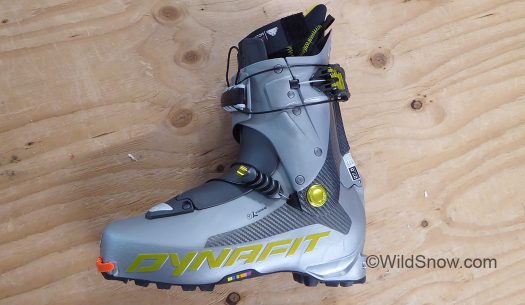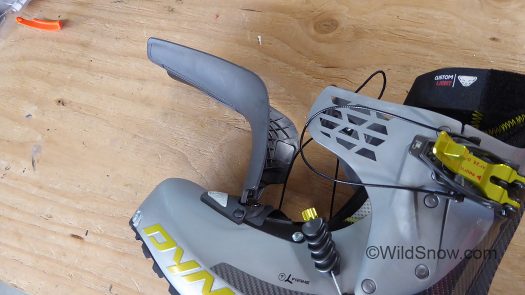I’m amazed and delighted by this shoe. Firstly, I’m here to tell you that we have in the TLT-7 much more than a model iteration. This is easily one of the most innovative boots to drop in the last few seasons. It’s like a Tesla coming after a Prius. From the one-motion mode change that actually might be best-ever, to the chop toe, to the through bolted heel fitting, super.
But more, let me brag. This boot incorporates a goodly number of TLT boot hacks and innovations we’ve made here in the WildSnow mod shop over the past decade. Yes, imitation is the sincerest form of flattery. Thanks Dynafit! Let me count the ways, with linkage to some of our mod posts.
1. Through bolted heel fitting.
2. Relocated instep cable pressure. (we relocated the lower buckles on all my former TLT boots.)
3. Hinged tongue (I added a small hinge from the hardware store to my first pair of TLT-5).
4. Possibly less wear-prone cuff pivot rivets (designed with Bill Bollinger).
5. Wider forefoot box (we’ve been punching out TLT boots for years).
6. Optional power strap (in retail box but not attached.) We almost always removed.
7. Lower buckle that doesn’t catch or open during snow or rock climbing.
8. Total elimination of vestigial buckles at the toe of boot (old news, but belongs on the list since we got a lot of grief for ripping the lower buckles off 4-buckle boots.)
9. Grinding duckbill toe off boot to the greatest extent possible. (We couldn’t produce a “Shark Nose,” but we tried.)
10. Modification of Ultralock plate to change forward lean.
11. Elimination of metatarsal flex in the first generation TLT (us and blog contributors).
Okay, I got to brag. Moving along…
First, let us put one question to bed. Is the TLT-7 last wider than the TLT-? Definite answer is yes, comparing my TLT6 with punched out metatarsal, the outside width of the 7 is still 3 mm wider. According to Skialper Magazine, which actually measures the last width of a 27.5, the TLT6 has a 99.5 mm internal width, while the 7 measured at 100 mm. That doesn’t sound like much (and makes me wonder if Skialper might have changed their measurement methods), but every bit can make a difference to sensitive feet. More, in real life terms they reshaped the TLT last significantly, especially in the toe area and over the forefoot. Comparative testing of this is easy, you just shell fit each boot on a stocking foot. The 7 clearly feels overall more roomy. In my opinion it’ll be easier to fit and warmer, while not being so commodious as to bum out those of you who like narrow lasted boots.
(Podiatry teaches us that the foot is actually something like a “sack of bones” and squishes around to use additional shoe volume that’s not always in the exact spot you would assume. In other words, while the specific last width might not be all that much wider in the 7, the overall increased volume can make it feel significantly more commodious. Adding to that, the 7 has less layering of plastic getting in the way of shell width “punching” modifications, as well as still using easily heat adjusted Grilamid plastic.)
Ankle width of the 7 is slightly wider as well. I compared using my interior dimension caliper, which doesn’t give me exact millimeters but does yield good visual evaluation. Measured outside with my external caliper, the 7 is about 3 mm wider than the 6. (Remember outside boot measurements are dependent on thickness of shell plastic, so they’re only a rough guide.)
Weights are interesting. My 27.5 TLT-6-P (shell only) with power strap and without add-on tongue comes in at 958 grams, while TLT-7-P shell comes in at 882 with power strap (it has a permanently attached tongue). That’s a significant difference in mass that’s even greater when you add the “real” tongue to the TLT-6-P. Takeaway here is Dynafit clearly made a boot model upgrade that doesn’t suffer dreaded “weight creep” that sometimes happens in lightweight ski touring gear.
Big deal with weight here is ourselves and others in the industry have informally created a “category” of “real” ski touring boots. Big criteria is weight around one kilo per boot. TLT-7 is right in there. Our sample 27.5 without power strap but otherwise fully configured come in at 1,018 grams per boot.
Note we tend to do boot weight comparisons without liner installed, as many skiers add multiple liner customizations or simply swap out the liner for something they like better. Be that as it may, rest assured that the 7 liner is about as minimalist as you can get (164 grams with stock footbed). Its weight is not an issue.
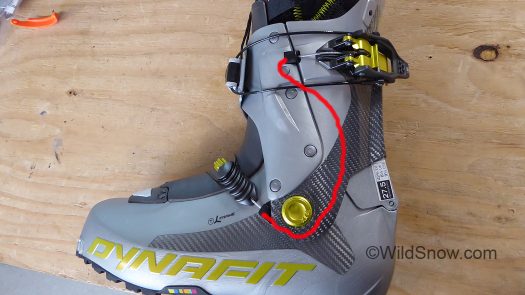
Hidden cable routing for one motion buckle operation. The upper buckle is actually two buckle levers that work either independently or in concert (see video and more photos below). While we do like this setup, it’s perhaps a bit over hyped. Reality is that the TLT 5 and 6, when set up correctly, can easily be switched between up and down modes by flipping the one upper cuff buckle. Difference here is not only does the TLT-7 buckle remain low profile (it doesn’t stick out from your boot like a tree branch), but the the 7 buckle system also opens the entire boot with one flip of a buckle and a little pulling at the closure cable loops. Perfect for when a skier needs hypothermia treatment and you need to quickly jump into a sleeping bag with him or her. (Seriously, any added convenience in ever fiddly ski tour gear is welcome).
The hidden cable operated closure system needs exposition. It looks more complex than it is. Upper cuff buckle is actually two levers. One (black) is attached to the cuff closure cable loop and can be operated independently, the other (greenish anodized aluminum) is attached to a cable routed down to the instep closure over the tongue. When you first don the boot to begin a tour, you buckle with the black buckle which puts you in downhill mode. Adjust all your tensions so they feel good for down-skiing, then simply flip the upper black buckle out, which opens and releases the cuff for touring.
Ideally, throughout the day, simply flip the black buckle to go from downhill to uphill mode and back. Long term testing needs to occur, but for now I’m truly impressed by this system. The upper buckle(s) is much more low-profile than the TLT 5 and 6, and also entirely opens your boot with one motion (more on that below).
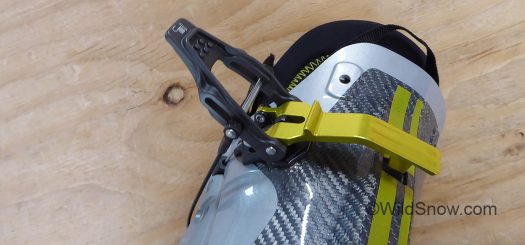
The ‘double buckle’ of the TLT-7. Black controls only the upper cuff. Once you enter the boot and everything is adjusted for the day, you just flip the black open and closed to switch between uphill and downhill modes. When you flip the black to uphill mode, it releases the green buckle from the lean lock by lifting the green buckle a few millimeters. Ingenious. They call this whole system Ultralock 3.0. It continues to use the Dynafit patented and beautifully simplistic lean lock consisting of a small aluminum tang on the buckle, that inserts in a hole at the rear of the boot cuff. Clearly still one of the best lean lock systems in the industry.
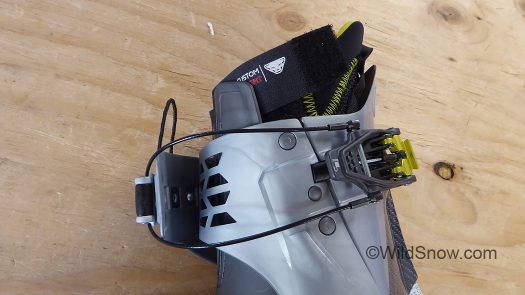
Ultralock 3.0 open for touring. Said again, making this move lifts the green buckle up out of the lock hole at rear of boot cuff. The instep buckle remains snug with perhaps a nearly imperceptible easing. Using this system for a truly one-motion switch between up and down modes requires properly fitted boots, as you’re limited to one instep buckle setting that doesn’t snug up for the down the way people tend to do manually. Update per reader comments: Note the small black cord loop coming up from front of cuff. This is intended to position the power strap and needs field evaluation.

The ‘double buckle’ of the TLT-7. In this photo you can see how lifting the black buckle lifts the longer colored buckle tang out of the Ultralock lean-lock opening. This photo shows the somewhat short liner spoiler that could cause comfort problems for some folk’s calf shapes. Easily fixed with boot fitting skills or aftermarket liners.
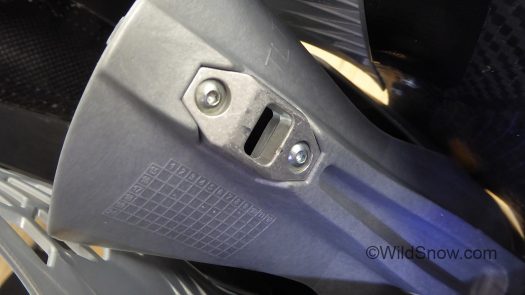
Ultralock 3.0 uses same interior aluminum plate as ver 2.0, you can flip this for more or less forward lean by a few degrees.
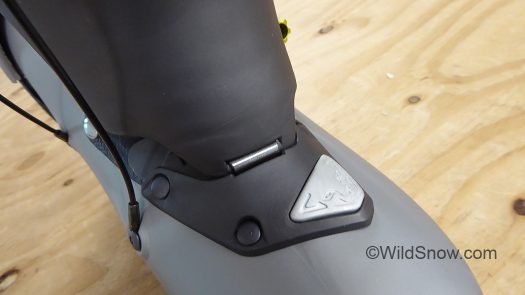
This TLT boot does not have removable or add-on tongues. Instead, a permanently attached tongue not unlike that of the TLT-6 is hinged for easy entry and exit. In the way of many modern ‘tongue’ type ski touring boot shells, TLT-7 depends on the rigid rear spine of the shell for resistance to forward flex, rather than depending on how stiff the upper part of the tongue is. It would be trivial to mod this by adding a plastic layer to the tongue, but in my testing I see little need for most skiers to do this, due to how well the shell resists bulging at the cuff pivots, which is the mechanism by which these type of boots ‘collapse’ forward under aggressive skiing.
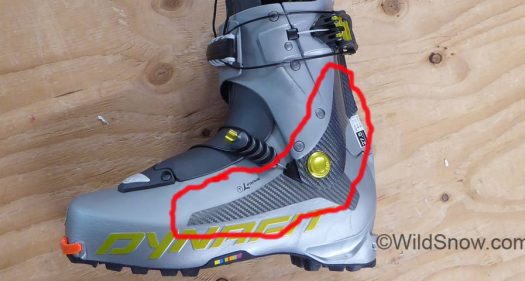
Spine and outside of boot lower shell are reinforced with a fiber composite molded in with the boot plastic. This all appears more sophisticated than TLT-6-P though we doubt it skis downhill any better. Which is not a criticism, as the 6 does the job quite nicely. I do wonder why they didn’t build the fiber composite into both sides of the scaffo, as during carpet testing you can clearly see how doing so would have contributed to ever more stiffness by preventing bulging. Or? A ‘tongue’ boot can be too stiff. Perhaps Dynafit did this intentionally to tune the forward flex.
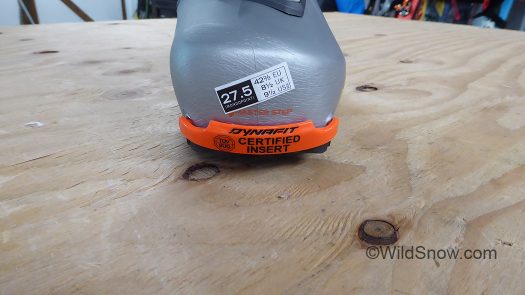
Dynafit ‘certified’ fittings are indicated by this clip-on seal. Is this a big deal? Depends. If you know what you’re doing, or working with a competent ski shop, binding release and retention can be evaluated in such a way as to give the nod or nix to any given boot fitting and binding combo. On the other hand, the boot fittings in the tech system are very much a part of the binding mechanical systems. Without an industry DIN/ISO standard for the fittings, some sort of standardization can be valuable. I don’t want to write another thousand words on that issue here, as we’ve already written 500,000 words on it. Try this site search.
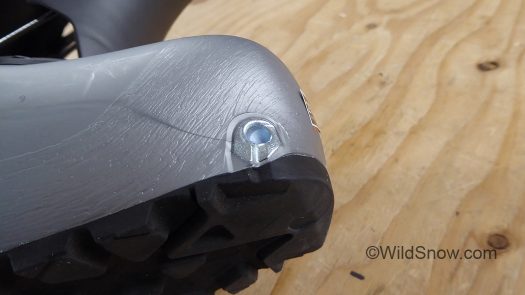
Dynafit uses their new toe fitting version they call Master Step. These are intended to make binding entry easier while preventing accidental release at odd angles. I’m of the opinion that experienced users will be fine with any version of tech fittings, while Master Step is helpful for newcomers to the tech system.
Only real downside to the Master Step is the added size eliminates room for more boot rubber, thus creating a wear prone spot for people who do a lot of hiking or rock scrambling in their ski boots. For that reason, I have a constant itch that will only be scratched when Dynafit goes back to the old style fittings in their high end boots. But that’s probably not going to happen. It would be like that Tesla dragging a 2-inch receiver hitch.
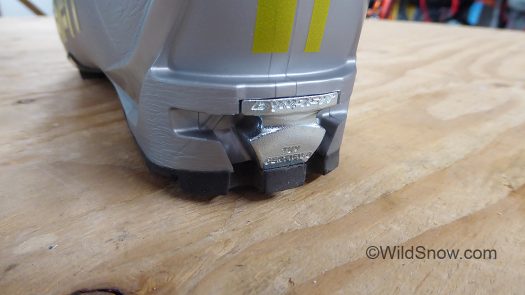
This is big. Heel fitting is attached using a through-bolt type of fastener from the inside of the boot (this can be viewed by simply pulling the liner and looking down inside the boot heel area). I’d actually call this the uber feature of the TLT-7, as it probably eliminates an inconvenient or downright dangerous failure mode.
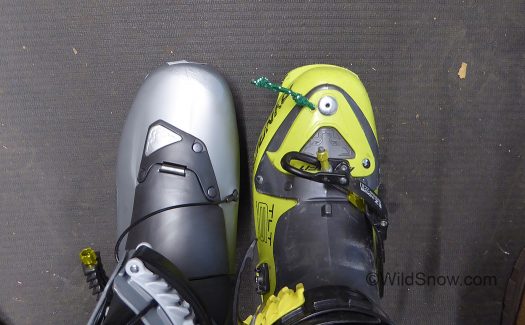
Comparison of TLT-6 toe box (r) and TLT-7 widths, you can clearly see the extra volume of the 7. Toe box of 7 is slightly higher as well.
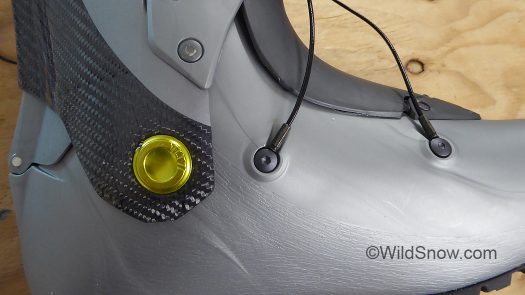
Instep closure is via wire cable loop and an adjustable ladder ankle. This system gives much better pressure distribution than TLT-6 as well as locating one of the cables up higher on the instep for that ‘locked in’ feeling many of us desire in a ski boot; that’s not well provided by having one buckle lower down on the shell over your foot arch.
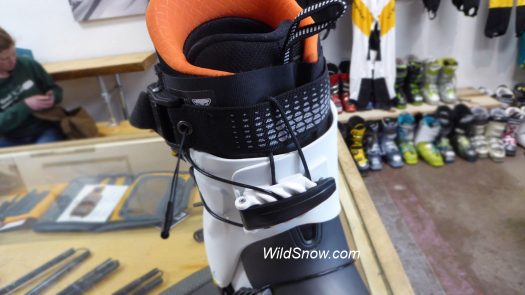
Shell closure flaps include a mysterious black cord loop. This is intended to solve the ubiquitous problem of power straps riding up too high, and also keeps the power strap from being tangled inside your pant cuff. We’d recommend trying this boot without the power strap, as using the strap kind of makes a mockery of the ‘one motion’ mode change system. (This photo is the Dynafit ‘Expedition’ model boot, not the TLT-7).
Other thoughts: Yes esteemed WildSnow readers, you can’t use “toe bail” style crampon on the 7 without an adapter. On the other hand, perhaps this will encourage crampon makers to build spikes that utilize tech fittings for attachment, such as the Techcrampon 250, (Which is said to work fine so long as you order the current version.) Another concern with TLT-7 is the liner being rather short at the rear shell spoiler. This could be uncomfortable for folks with certain lower leg and calf shapes and require an aftermarket liner or boot fitter mods. In terms of weight, just as with skis a big marketing target for ski touring boots is ONE KILO! Obviously, the 7 reaches that target in fine style. Thumbs up.
Metrics and specs:
Official weight, industry standard sample size 27, 1,010 grams.
Weight of our 27.5 testers, no power strap, 1,018 grams.
Women’s model? This boot is unisex, as most if not all ski touring boots actually are — other than color stereotypes.
Plastic type is Grilamid, so ease of heat punching will continue.
Shell breaks
(22.5) (23 – 23.5) (24 – 24.5) (25 – 25.5) (26 – 26.5) (27 – 27.5) (28- 28.5) (29 – 29.5) (30 – 30.5)
As always when it comes to ski touring boots, we recommend several boot shopping options. If you know what you’re doing, etail can work. Backcountry.com has ’em. Otherwise, seek out a local shop. Our website financial supporter who loaned us our evaluation boots Cripple Creek Backcountry is a good example, to find a “real” shop near you see our Best Ski Shops post.
WildSnow.com publisher emeritus and founder Lou (Louis Dawson) has a 50+ years career in climbing, backcountry skiing and ski mountaineering. He was the first person in history to ski down all 54 Colorado 14,000-foot peaks, has authored numerous books about about backcountry skiing, and has skied from the summit of Denali in Alaska, North America’s highest mountain.

